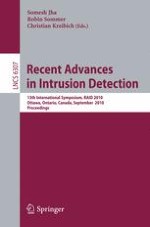2010 | Buch
Recent Advances in Intrusion Detection
13th International Symposium, RAID 2010, Ottawa, Ontario, Canada, September 15-17, 2010. Proceedings
herausgegeben von: Somesh Jha, Robin Sommer, Christian Kreibich
Verlag: Springer Berlin Heidelberg
Buchreihe : Lecture Notes in Computer Science
